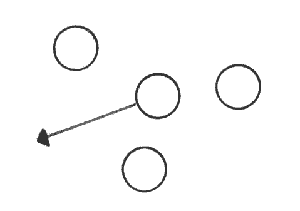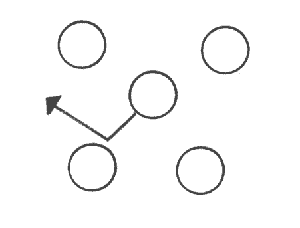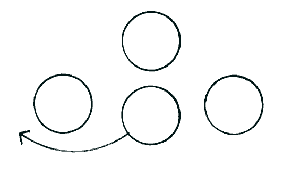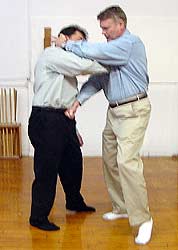Surviving A Multi-Opponent Attack
Part 4:
Maneuvering For Advantage:
Putting It Together
by Christopher Caile
Editor's note: This is the fourth of a series of articles
exploring principles, tactics and techniques that can be used when confronted
with multiple attackers.
It has been said elsewhere in this series of articles, but let me state
it again:
Proper movement against multiple opponents is a critical element, one
that can help even the odds and help you survive. But it is also the least
understood. It is the strategy underlying the principles and tactics discussed
in Part 2 and the basics of stances and movement in Part 3. This and the
following segment ties it all together.
Basic Strategy Of Movement
When facing multiple attackers never let them take up an attack formation,
and if they do, disrupt it, distance yourself, move to the side or break
out from it -- move so the attackers block or trip over each other, move
so space separates you from as many of them as possible, or move to line
them up so you can deal with them one at a time. If you can't go around
someone, go under him, or push him into another. If an attacker gets behind
don't let him get close, and if he is close either move away quickly or
attack him. In short, always move to a position of advantage and don't
let them have one. In each case the space between you and your attackers,
as well as their positions, and movement define how you should move.
A number of examples discussed below illustrate how this strategy is
put to use. Remember, however, there are no fixed rules, just guidelines.
You might do everything right and not succeed, or do everything wrong
and escape. But these guidelines will increase your odds of success. In
many of these instances your initial movement may enable you to break
free and escape, but the defender in the illustrations below continues
to fight.
In his 1933 book, Aikido's founder, Morihei Usehiba, discussed the principle
of movement -- to use distance and spacing as if it were water, like a
moat around a castle. "When the enemy attacks you with fire you defend
with water ... when the enemy comes to strike you, open up (as) with water
so you cannot be struck." Elsewhere he says, "Defeat your enemy
by securing a safe and undefeatable position." There is an old Japanese
expression that puts this very succinctly: "Be water, not the rock."
Some of the principles demonstrated are also illustrated in several karate
Pinan kata as discussed in the footnotes to this article.
Plays In Your Game
Here we will discuss several basic formations, but remember that attackers
are often moving, so any position may be just momentary. Any attack can
be understood as a flow of energy, something constantly changing and adjusting.
Here, however, we have frozen the action to analyze relative positions
in terms of movement, distance and time.
Of course if in any of these situations you are indoors where there is
furniture, as you move you can use anything moveable, such as a chair,
stool, bench, or table -- as a shield or barrier or as an obstacle in
path of your attackers. If outdoors there are often things that can be
picked up, shoved, or tipped over to be used in the same way. You can
also move around a fixed object that momentary blocks a path to you. Useful
is any large object, such as cars, trees, crates, and large bushes.
1 - Surrounded
This is the scenario often depicted in books and videos, but in reality
it is a very dangerous position (to fight from the middle). You could
win, but you are doing it the hard way. And you have to be very lucky.
By staying in the middle of attackers you put yourself at a needless
disadvantage because you give up both initiative, time and spatial position.
You can be attacked from any direction and at any time and the attackers
make the decisions. For the most part you just react. And while you might
keep people away with kicks, punches and other techniques, they can also
easily close in around you. This doesn't mean you can't ever fight from
a fixed position, but it does suggest that you shouldn't make it a career.
If you do, you may be doomed to involuntary early retirement.
The strategy when surrounded is to move to break out between two attackers
or stretch the formation. If there are three opponents around you, for
example, and they are not too close, you can usually step quickly between
two of them and get to the outside.

If, however, when you move to get outside and the opponents react by
retreating to keep you enclosed, you still have a modest victory. You
have still stretched their formation and created room to your backside,
if only for a moment.
Now you will most often have only two people near you. You can then move
towards one of them. This may be a half step or several. The idea is to
isolate one attacker by moving into him. You also and create a little
space or time between you and the second. You have begun to dictate the
terms.

Here, however, you want to do something more. You want to get to the
other side of the attacker you are approaching, so he becomes a physical
barrier. Thus, you combine two of the movement patterns discussed in the
last segment: the "quick advance" and the "slide or angle
past." If the two attackers were at any distance, you would approach
one very quickly using the striding steps discussed in the last segment.
(1) If you are close you can also pivot
around an attacker, something helpful if the attacker's blows are beginning
to land.
There are three advantages gained by moving to the side or behind and
opponent in this situation. First it sets you up to throw, push or so
control the attacker (see "Use Your New Friends" in Part
1), to the ground, out of the way or to be used as a barrier
or a weapon. Secondly, even if you are still trading techniques with this
attacker you can maneuver from side to side or circle to keep him between
you and another (a moving barrier) opponent. Finally, you avoid exposing
your back to another assailant who might quickly move in on you.
In these situations advantage is only momentary. Other attackers may
be moving in fast. So, you want to deal with or control attackers quickly,
and I mean very quickly. If you just dance around eventually someone will
get to you. Also keep 360 degree awareness. If others are approaching
it may be time to zig zag, change direction, pivot and be unpredictable.
If the formation is back to three around you again, you may just have
to start over.

If surrounded by four or more attackers, getting outside their ring is
a little more difficult. So, you have to be a little more creative. Again,
here we are assuming you have a little room and not in an enclosed area.
One tactic is initially to move into one of the attackers. This creates
a little space at your backside from others across the ring, and from
the next closest to you on the outside. If you can overcome him with your
initial assault, great, but don't linger. At minimum advance and attack
(zig) and then change direction (zag) into an available gap in the ring
to get outside. When you are close to one person you can also pivot to
the outside. Again you are back to the first illustration of handling
two men at a time. The others are too far away for the moment to get to
you.
2 - The Wall
In this scenario multiple attackers (here three) are lined up in front
of you or walking towards you. The formation resembles a wall.

Odds three to one aren't bad at the track, but in the street if you lose
it's not your paycheck. Again, the movement strategy is to move to the
outside. Outflank them. It's like an end run in football, but it's you
alone and you don't have blockers. So get to the outside fast. Usually
one long and fast step or several quick steps will do it. In the process
you might have to do a quick offensive move against one or more attackers,
but we will leave this subject for a little later in the article. We want
to concentrate first on movement.
When you get to the outside, pivot to face the closest attacker. You
have again taken positional advantage. Your opponents are lined up, the
man on the outside is in front of the man in the middle, who is in front
of the person at the far end. And if they aren't blocking each other,
at least they are all not on top of you -- you have dispersed the troops.
You can now concentrate on the closest one. If they are standing very
close to each other, the bump and run is very effective (discussed in
the last segment). This entails pushing, striking or kicking the closest
opponent backward into the others standing close behind. They begin tripping
and become unbalanced -- a little more time.
If in a hallway, when you move past attackers on one side, both the walls
and the attacker's bodies can restrict movement of other attackers. If
in a stairwell, positioning yourself on a higher stair gives you positional
advantage. Room for movement is limited and from above kicks can here
be especially useful, if your legs are not caught and pulled out from
under you. (2)
3 - The Loose Half Circle
In this example three attackers have closed around you in a half circle,
but are not crowding you. There is one at your front and one at each side.
They could be just threatening you, or starting to take action.

If someone attacks, or course, you have lost the initiative. But there
are times when you just don't know you are going to be attacked. Thus
it is always important to maintain a state of heightened awareness when
others are around because if you don't see an attack coming you could
be finished.
If an attack starts, your first reaction is to react, But, while you
are jamming, blocking or otherwise defending, don't forget to move. You
might also just move to avoid the attack altogether. If you just stand
there, other attacks will probably come from the side or behind. A favorite
tactic of gang attacks is to have one person hit, grab or otherwise occupy
you while the others jump on like a rabid wolf pack.
The best idea is to take the initiative, attacking while moving too.
Similar to the wall example above, here too you want to get to the outside
-- around an attacker on the outside, or through him if you have to. Again,
by moving to the side you are creating a momentary space to your back.
The other attackers can no longer get to you, and just like "The
Wall" example use above, you have outflanked their formation and
taken a positional advantage. The attackers are spread out, lined up and
you are on the far end. By the time others can move to the side and forward
to engage you, hopefully you have already dealt the attacker nearest you
and moved again.
You might use the attacker on the end as a barrier or shield while moving
toward the third. Again, you are back to dealing with a two person situation.
If there is a wall behind you things are more difficult. You might fake
a move in one direction and then move in the other -- a mini zig zag.
Just moving quickly toward someone and attacking can create a reaction,
such as a defensive shift, or flinch (freezing his movement) you can use
to get to the outside.
If an opponent attacks, he is becomes momentarily unbalanced. Deal with
the attack but also move past or if the space is tight, slip and slide
-- that is, get one foot and leg between him and the wall and slide past
him using your forward arm against his shoulder to propel you past (also
discussed in the last section).
A Note On Attacking
When moving toward someone don't hesitate between techniques, waist time,
or stop your movement. Try to do two or three things at once. Don't block
then counter. Do both together. Don't kick in such a way as you have to
recover your balance before you can punch. Combine them. Combine movement
with a fast flurry of techniques that bridges all the ranges of distance
to, or past, your opponent.
If your opponent is beyond your reach of your hands or feet you may use
an improvised weapon (chair, barstool, brief case, umbrella, etc.) if
you have one, or throw something. From this distance you can also attack
your opponent's punches or kicks.
Moving closer your opponent is in range of a fast low kick, or kicks,
combined with punches or fast open hand techniques to the eyes, neck or
groin.
Still closer these techniques can progress into elbows, knees, leg sweeps,
trips and shin kicks.
Finally (if you have not moved to the side) you can head butt, foot stomp,
use a hand attack to the groin, or use your hip and/or shoulder to bump,
or push -- a never ending series of technique that come so fast that it
overpowers the attacker.
If you have moved to the side of the opponent you can spin, throw, trip,
take down, unbalance or control him, or just continue your attack from
this position of advantage.
Once practiced you should be able to execute 10-12 of these techniques
in less than two seconds -- about all the time you have in many situations.
Here knowledge of vital points and the body's natural reflexive responses
to pain are helpful (see
segment one).
Additional scenarios will be discussed in Part 5 of this series.
Footnotes:
(1) The Pinans also illustrate breaking
out of a circle of attackers by using a quick step, or a straight multi-step
movement patterns, such as found in the middle of Pinan #1 (three quick
steps) which in the above example is used to move between attackers (3
man scenario). Pinan #3 illustrates another pattern -- a step and pivot
plus another step which is similar to moving into a person, then pivoting
around him. This is one option to use in the example of being faced with
four or more attackers. Of course, in Pinan #3, a knife hand trust turns
into a 360 degree pivot ending up in a horse stance with a strike with
the side of the fist. Then there is a step forward with a punch. But,
here we are examining movement patterns only, not techniques.
In both of these pinans after a short sequence of several steps the forward
movement in the kata stops and changes direction to the side -- just as
if you broke through a ring of defenders and then moved toward one of
them, only to turn the opposite way to move toward another attacker.
It is as if after defeating one attacker you turn and move to the next
in the other direction. In each pinan the pattern then moves back towards
the starting point, just as if the defender (having defeated the attackers
on one side of the circle) is moving to confront those elsewhere (the
ones originally moved away from).
(2) Both "The Wall," and "The
Loose Half Circle" scenarios discussed draw on strategies of movement
found in Pinan #1. In each, the defender's first move is to the left,
just like in the scenarios above. But, you can also attack the person
in front of you as part of your movement to the left.
Many techniques could be used for this frontal attack. It would be quickest,
however, if the technique was a quick and natural extension of whatever
technique was extended to the left with the step taken in that direction.
In Pinan #1 this is a left lower block.
It is within this initial movement that the front strike appears. What
looks like the preparation for a downward block disguises the technique.
Either hand can be used for the attack, but combined they are very powerful.
Below, each hand is discussed separately.
First we will address just the right arm which is held straight and down
as part of the preparatory movement to execute a left down block. Three
possible applications are discussed.
If your attacker is standing very close (nose to nose), the back of your
hand (your right arm is down at your side and you are standing in a natural
stance) can be used to slap into the attacker's testicles (if male). Here
the fingers are used and the wrist kept loose (a whipping slap, not a
hit). Patrick McCarthy, the well known karate writer and historian, once
demonstrated this to me, saying it was a favorite "in and close"
technique of many of the old Okinawan Karate masters.
Still talking about the right arm in what looks like preparation for
a down block, a more forceful approach could be a short punch into the
lower abdomen or right hip of the person in front.
Another variation, and one Mas Oyama used to demonstrate quite effectively
on me, was to keep the right arm straight and swing it forward with the
hips behind it. This way the arm would be used like a club, the fist striking
into any low target directly in front.
Any of these techniques using the right arm will work over several ranges,
from very close to almost arms length -- to stun the opponent and cause
pain. Most likely the opponents head and chest will move forward too --
a reflexive reaction to the blow.
Next, we will discuss the use of the left arm that is positioned in preparation
for a left down block. The left hand starts at the side of the body. The
path used to bring it upward across the body (as part of the block preparation)
also can be used to attack a person in front. Since the upper chest and
head of the opponent is also moving towards your technique, it impact
will be amplified.
If the head is close, the bent elbow of the block can be used to strike
the face or head. If the head is a little more distant the rising arm
can turn into a rising hook-like strike into the chin, side of the face
or neck. If the distance to the head is even further away, the palm of
the rising arm (the elbow is less bent) can hit the side of the face or
chin, or the fingers can be extended further still into the eye of an
opponent as a finger jab or splashing hands.
 Shown
here is one combination of options using both hand together -- a right
short punch with the right hand into the opponent's right hip combined
with an upper left open hand strike into the side of the opponent's head. Shown
here is one combination of options using both hand together -- a right
short punch with the right hand into the opponent's right hip combined
with an upper left open hand strike into the side of the opponent's head.
Whatever the initial attack is to the front (if there is one) the defender
then continues to move to the side. In an actual confrontation the hand/arm
or kicking technique would be tailored to the attack or defense used.
Here, however, we are talking about movement pattern, and the pattern
seen in Pinan #1 would be used. Thus a long step is used (front leaning
stance) followed by another and then a 180 degree turn. The steps move
you into one opponent and away from another, thus creating space at your
back, just like in the scenarios.
In the kata the turn is usually seen as little more than a change of
direction to face another attacker. But the turn can also be used to use
the body of the first attacker (spun, pushed, tripped or thrown) to stop
or interrupt another attacker while you deal with a third.
In this way the many turns, pivots and change in directions found in
the pinan and other kata can also be understood to have other important
uses. Those who have studied the throwing, jujutsu or similar arts, Japanese
or Chinese, often see applications jump out at them when they study karate
kata. This makes sense, since karate developed on Okinawa as an amalgam
of Chinese and indigenous fighting arts with perhaps some Japanese influence.
Part
I: Interfering With And Avoiding An Impending Attack
Part 2 Principles & Tactics
Part
3 Maneuvering For Advantage: Basics
Part 4 Maneuvering For Advantage: Putting it all together
Part
5:Maneuvering For Advantage: More Scenarios
About the Author:
Christopher Caile is the Founder and Editor-In-Chief of FightingArts.com.
He has been a student of the martial arts for over 40 years and holds
a 6th degree black belt in Seido Karate and has experience in judo, aikido,
diato-ryu, boxing and several Chinese fighting arts. He is also a long-term
student of one branch of Traditional Chinese Medicine, Qigong. He is a
personal disciple of the qi gong master and teacher of acupuncture Dr.
Zaiwan Shen (M.D., Ph.D.) and is Vice-President of the DS International
Chi Medicine Association. In Buffalo, NY, he founded the Qi gong Healing
Institute and The Qi Medicine Association at the State University of New
York at Buffalo. He has also written on Qi gong and other health topics
in a national magazine, the Holistic Health Journal and had been filmed
for a prospective PBS presentation on Alternative Medicine. Recently he
contributed a chapter on the subject to an award winning book on alternative
medicine, "Resources Guide To Alternative Health" produced
by Health Inform.
|